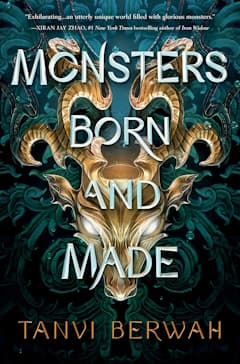
Monsters Born and Made by Tanvi Berwah
(Sourcebook Fire, 2022)
Reviewed by Ksenia Shcherbino
As a researcher interested in hybridity and social constructs of monstrosity, I could not miss Tanvi Berwah’s new book, Monsters Born and Made. Monsters, angry teenage girls, and social inequality seem like a perfect hotpot mix to explore liminality and social exclusion, and the novel lives up to its recipe. It is fast-paced and engaging, it is full of violence and gore and teenage angst, but the questions it raises invite a slow read.
We follow Koral, a young monster hunter, through all the four stages of her coming to maturity. The setting is vaguely Dickensian with a twist worthy of Arthur Conan Doyle writing about Godzilla. On one hand, grim realities of a poor family, once relatively mighty, but now not blending in with their community, due to their hereditary profession of hunting and breeding maristags: scaly and violent sea creatures that reminded me of a hybrid between a Komodo dragon and a goat (and of some of the old computer games as well. I later discovered that Tanvi Berwah was actually inspired by marine iguanas). The rich, or the Landers, don’t care, the common folk despise them for trading with the rich. Moreover, their earnings are seasonal, so if they haven’t caught enough monsters in high season, they will have to starve for the rest of the year. An elder brother badly injured in a hunt gone wrong, a younger sister dying of a consumption-like disease, a greedy apothecary refusing to dispense medication without upfront payment. Their loan is denied, and they are banned from the black market. The family is dysfunctional—the father often beats the mother and the children, the mother is too tired and has long lost her beauty and her smile, and there are no fairy godmothers to come to their rescue. And then there is a monster chariot race that is traditionally reserved only for the high and the mighty—and Koral decides to join the race against all odds in the hope of winning enough money to give her family a chance.
A chariot race has always been laden with symbolism. On one hand, it is an ancient metaphor for high stakes, power politics and the hero cult so prominent in Graeco-Roman culture. Achilles was a charioteer. The winner of a chariot race acquires status, legitimacy and some sort of magical inviolability—exactly what Koral, a low-class trying to play the violent game of the rich, needs. The exclusivity of chariot races is also a historical fact, due to enormous costs of raising and keeping racing horses. Yet at the same time, races—from Ancient Greece to Ascot—have always been a marketplace for social identities, a place of hybridization and make-belief, so it is a perfect background for a hero transformation, however improbable it might be.
Koral is not a lovable character. In fact, for half of the book I found her self-centeredness, self-righteousness and self-imposed determination to quarrel with literally everyone who comes her way quite annoying. I am not a big fan of The Hunger Games, and it's hard to sympathise with a teenage porcupine, even if her circumstances are calling for your sympathy. Yes, there is something undeniably appealing about her, her ferociousness, her determination, her unyielding belief in the possibility of redemption and acceptance, her love for her family. She is no less a monster than everyone else about her, yet hers is a monstrosity of circumstance, an innate unfairness of the world. She yearns for gold, and power, and status and acceptance, but most of all she yearns for the freedom to be out of these constricts, for the freedom not to be written into the sealing definitions of her world. “Those words—anger, violence, warped mind—… the weapons their sophisticated society uses to discard us. Me. As if anger is why I am small.”
And her freedom is not simply a breakthrough, and not a simple reversal of chances. It is something bigger, an identity that transgresses all the boundaries imposed on her, that breaks (both literally and metaphorically) all the glass ceilings constructed around her. And in this process, she herself becomes a creature of myth, the ultimate hero, Icarus, who challenged the Sun and whose future is left beyond the margins of the story.
In this sense Monsters Born and Made follows the typical structure of a bildungsroman as it takes us through all the four stages (loss-journey-conflict-maturity) of the main character in the first person singular, but it is also a roman about concentric circles of inclusivity and exclusivity that every teenager at all times and in all worlds however magical has to navigate to become an adult. It flirts with the possibility of social mobility, promising a big prize in a glory game, yet it turns upside down all social ties of belonging to a family, friendship group, guild or class. To reach her true potential Koral has to get rid of all definitions: she is no longer a daughter, a sister, a friend, a rebel, a pariah, a low-class upstart, a charioteer, a champion, a sacrifice. She is not even a Hunter as she challenges the idea of monstrosity as a social, not biological construct. She used to fight maristags, the creatures of the sea, yet she discovered that the couloirs of her home world are populated with far more vicious creatures. She faces betrayal after betrayal, she loses and she wins, only to lose again, she learns that a friend can turn a foe, and an enemy can offer salvation, and she challenges every law and every rule of her world to become—ultimately and irrevocably free. And this is far more than any old Bildungsroman can offer.
Review from BSFA Review 21 - Download your copy here.
